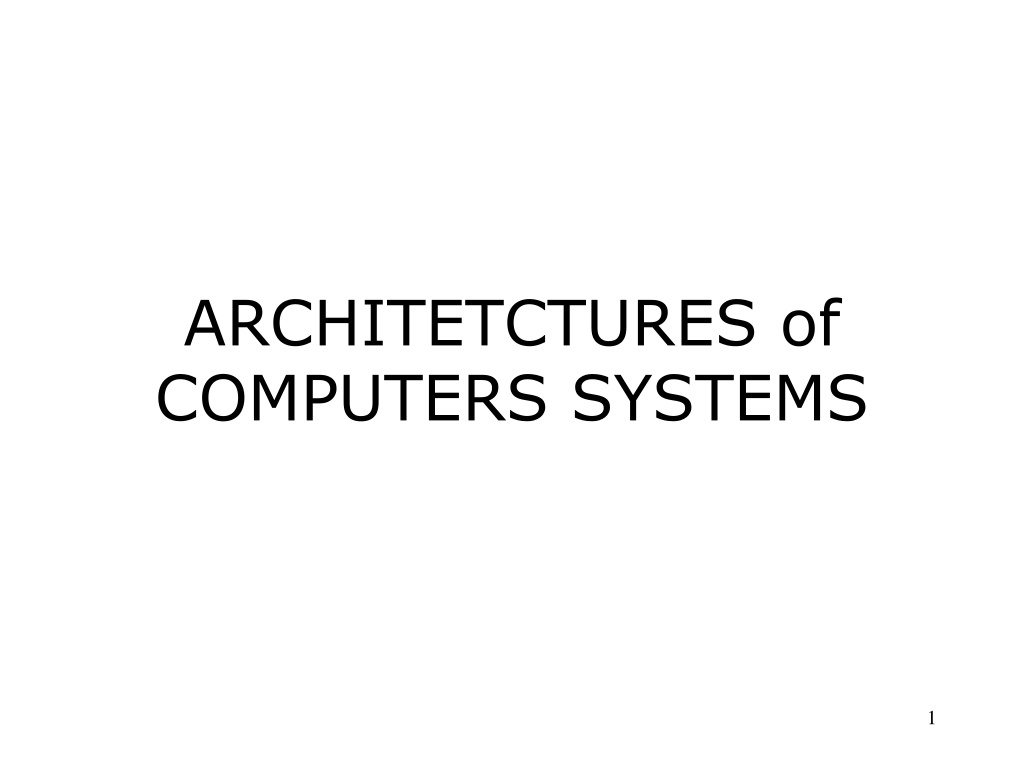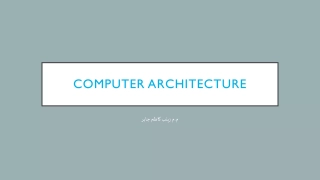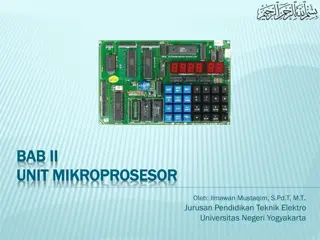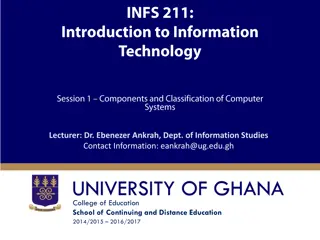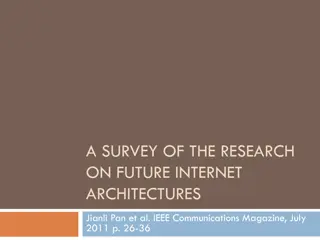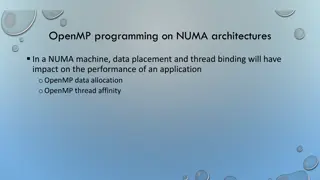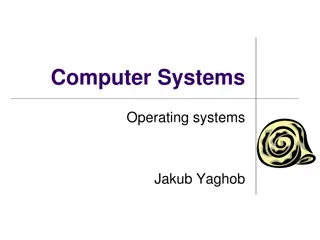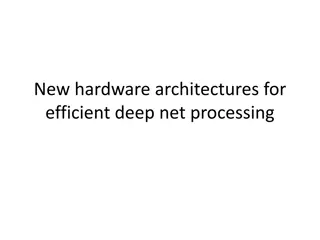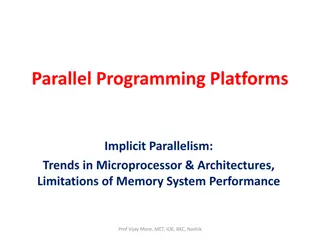Understanding Computer Systems Architectures and Standards
Open systems, standards, client-server models, and internet functionality are crucial components of computer systems architectures. Open systems promote interoperability, standards ensure technical criteria, client-server models define coordination, and the internet provides a communication infrastructure. These elements have evolved to facilitate efficient and reliable computing across heterogeneous hardware and software components. Embracing these principles is key to navigating the complex landscape of modern computer systems.
Download Presentation

Please find below an Image/Link to download the presentation.
The content on the website is provided AS IS for your information and personal use only. It may not be sold, licensed, or shared on other websites without obtaining consent from the author. Download presentation by click this link. If you encounter any issues during the download, it is possible that the publisher has removed the file from their server.
E N D
Presentation Transcript
ARCHITETCTURES of COMPUTERS SYSTEMS 1
Open Systems Distributed systems consisting of eterogenous hardware and software components from different system vendors. Unlike a propritary solution a open distributedsystem can be realized by using components from the different vendors. Utilization of standards (hardware, software) 2
Open systems are computer systems that provide some combination of interoperability, portability, and open standard software. The term was popularized in the early 1980s, mainly to describe systems based on UNIX, especially in contrast to the more complex mainframes and minicomputers in use at that time. Unlike older legacy system, the newer generation of Unix systems featured standardized programming interfaces and peripheral interconnects; third party development of hardware and software was encouraged. A significant departure from the norm of the time, which saw companies such as Amdhal and Hitachi going to court for the right to sell systems and peripherals that were compatible with IBM's mainframes. 3
Standard A technical standard is an established norm or requirement. It is usually a formal document that establishes uniform engineering or technical criteria, methods, processes and practices. Standard de jure: Hardware or software that is endorsed by a standards organization. Standard de facto: Hardware or software that is widely used, but not endorsed by a standards organization The standard concept is relative to the functional aspects of a component; the component may be realized in different ways. 4
CLIENT-SERVER MODEL Coordination model in a distributed system. It defines: Which process may begin the interaction Which process may answer How error conditions may be managed. 5
The functionality an internet provides Internet provides a general communication infrastructure without specifyng which services will be offered or how the services will be used. Such issues are left to application software and users. Although it provides the ability to communicate, the internet does not specify wich computers interacts or what these computers do with the communication service 6
Although an Internet system provides a basic communication service, the protocol software cannot initiate control with, or accept contact from, a remote computer. Of course, two application involved in a communication cannot both wait for a message to arrive. One application must actively initiate interaction while the other application passively waits. Most network applications use a form of communication known as the client server paradigm. A server application waits passively for contact, while a client application initiates communication actively. 7
Characteristics of clients and servers Client software: Is an arbitrary application program that becomes a client temporarily when remote access is needed, but also performs other computation locally. Is invoked directly by a user and executes only for a session. Runs locally on a user personal computer. Actively iniziates contact with a server. Can access multiple services as needed, but actively contacts one remote server at a time. Does not require special hardware or a sophisticated operating system. 8
Characteristics of clients and servers Server software is a special purpose privileged program dedicated to providing one service, but can handle multiple remote clients at the same time. runs in a shared computer (i.e. not on a user personal computer). waits passively for contact from arbitrary remote clients. accepts contacts from arbitrary clients, but offers a single service. requires powerful hardware and a sophisticated operating systems. 9
Server programs and server-class computers Formally, the term server refers to a program that waits passively for communication and not to the computer on which it executes. However, when a computer is dedicated to running one or many server programs ,it is sometimes called a server. 10
Application server Kinds of server services: mail server file server terminal server name server authentication server gateway server administration server . 11
A server must guarantee: authentication: client identity verification authorization: verification of the possibility for a client to access to a particular service data security: garantee that specific data cannot be read and/or modified 12
Information can flow in either or both directions between a client and a server. Typically, a client sends a request to a server, and the server returns a response to the client. In some cases, a client sends a series of requests and the server issues a series of responses (e.g., a data base server can allow to a user to look up more than one item at a time) In other cases, the server provides continous output without any request . As soon as the client contacts the server, the server begins sending data (e.g. local weather server might send continous weather reports with updated temparature and barometric pressure.) 13
Characteristics of a client-server architecture Client and server machines need different amount of hardware and software resources. Client and server machines may belong to different vendors. orizzontalscalability (increase of the client machines) and vertical scalability (migration to a more powerful server or to a multiserver solution) A client or server application interacts directly with a transport layer protocol to establish communication and to send or receive information. The transport protocol then uses lower layer protocols to send or receive individual messages. Thus, a computer needs a complete stack of protocols to run either a client or a server. 14
Identifying a particular service A single server-class computer can offer multiple services at the same time; a separate server program is needed for each service. Identifyng a particular service TCP uses 16-bit integer values (protocol port numbers) to identify services, and assign a unique port number to each service. A client specifies the protocol port number of the desired service when sending a request. 15
Dynamic server creation Concurrent execution is fundamental to servers because concurrency permits multiple clients to obtain a service without having to wait for the server to finish previous requests. In a concurrent server, the main server thread creats a new service thread to handle each client request that arrives. If multiple copies of a server exist, how can a client interact with the correct copy?How can an incoming request to be passed to the correct copy of a server? . 16
Dynamic server creation Transport protocol assigns an identifier to each client as well as to each service. Protocol software on the server s machine uses the combination of client and server identifiers to choose the correct copy of a concurrent server. . 17
Example: TCP connection TCP requires each client to choose a local port number that is not assigned to any service. When it sents a TCP segment, the client must place the local port number in the SOURCE PORT field and the server port number in the DESTINATION PORT field. On the server s computer TCP uses a combination of source and detination port numbers (as well as client and server IP addresses) to choose the correct copy of a concurrent server 18
Complex Client-Server Interactions A client application is not restricted to accessing a singleservice. The client may contact a different server (perhaps on a different computer) for each service. . A server for a service can became a client of another server. For example, a file server that needs to record the time that a file was accessed might become a client of a time server. While it is handling a request for a file, the file server sends a request to a time server, waits for the response, then continues handlig the file request. 19
Interactions and circular dependencies Dependencies among a pair of servers are easy to spot and avoid, a larger set of dependencies may not be obvious. Immagine a dependency cycle that includes a dozen servers, each oerating on a separate computer. If each server is maintained by a separate programmer, the dependencies among them might be difficult to identify. 20
STATELESS Vs STATEFULL SERVERS State information: information that a server maintains about the interaction state with the clients. The information state provides an incremental answer to a new request. The information state can increase the system efficiency, but problem may arise in the case of duplicated messages , delays and messages arrived out of order. 21
File server - remote access by clients . Two kinds of requests : Reading data from the file and writing data on the file. Stateless server It does not mantain informations about the transactions. Each request must specify the name of the file, the position in the file from which to extract or to insert information, the number of bytes to insert or extract. Statefull server The server mantains the state information about the files that accessed the server 22
Statefull server The server sends to the client the identifier of the previously open file. The client utilizes this identifier for the following requests. identifier position 1 2 3 4 file name current test.program.c tcp.book.doc dept.budget.txt tetris.exe 0 456 38 128 23
Statefull server Advantages: higher efficiency, incremental operations, lower dimension messages. Problems: comand duplication, delays, messages out of order, server crash (open files are not correctly closed). 24
Classification of client server structures In a client/server application three functions are present: user interface application programs data management Following the assignment of functions among client and server we have three possible types of structures: - host-based processing - server based processing - cooperative processing - client based processing 25
client server Presentation logic Application logic Database logic DBMS Host-based processing Presentation logic Application logic Database logic DBMS Server-based processing 26
Host- based processing is not true client server computing. It refers to the traditional mainframe environment in which all or virtually all of the processing is done on a central host. The user s station is generally limited to the role of a terminal emulator. Server-based processing. The client is principally responsible for providing a graphical user interface, while virtually all the processing is done on the server. 27
client server Presentation logic Application logic Application logic Database logic DBMS Cooperative processing Presentation logic Application logic Database logic Database Logic DBMS Client-based processing 28
Client-based processing. Virtually all application processing may be done at the client, with the exception of database logic functions that are best performed at the server. This configuration is perahps the most common client server approach in current use. Cooperative processing. That application processing is performed in an optimized fashion, taking advantage of the strenghts of both client and server machines and of distribution of data. 29
Three-level Client/Server Architecture The traditional client/server architecture involves two levels, a client level and a server level. A three level architecture is constituted by three types of machines: a user machine, a middle-level server and a back end server. The user machine (client) is typically a thin client. The middle-level server is the application server. The back-end server is the data server. 30
Legacy system A hold system (mainframe) which has not been removed after the installation of a new system. 31
COOKIES Information records that the server sends to the client together with the service answer. A cookie contains user informations informations on tha visited pages The following requests of the client to the server require the transmission of the relative cookies. 32
Cookies The server answer to a request of a client contains: Set-cookie: user identification number created by the server web Set-cookie: 1678453. The client inserts this information in a cookie file . The information includes the host name and the identification number of the client. In the following requests the client inserts the previous information . The server does not know the user name, but it is able to identify the client. 33
The web servers use cookies for the following objectives: To eliminate the need to require user name and password in order to authenticate the client. To store the user preferences To keep track of the objects that a client is buying on the web site. 34
